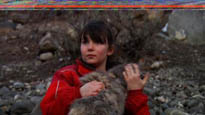One of the latest in a series of “99%” documentaries, Finding North explores poverty in America through one of its best-kept national secrets: its malnutrition epidemic. For Americans, it means one in six will experience food insecurity at some point in life. For Canadians, that means the stereotype that so tenuously separates us from them—the Fat American—no longer typifies a national character of individual greed and wealth, but a nation that starves its lower classes by stuffing them with junk food. The middle-class American is no longer strolling the Seven Wonders in a baseball cap and Hawaiian shirt; he’s standing in line at the food bank, loading up a box full of gummy worms.
Directors Lori Silverbush and Kristi Jacobson open with panoramas of lush mid-west farmlands and vast mountain ranges before focusing on three major food deserts—areas where healthy, affordable food is difficult to access—in rural Colorado, Mississippi, and urban Philadelphia. They talk to a pastor whose food bank has multiplied to the point where his fully stocked warehouse can no longer keep up with his community’s demand, the only police officer in the same town, whose wage is so low he visits that food bank too, and a fifth grader who survives on a charitable food bank with no mandate or capability to provide her with even a fraction of her nutritional requirements.
By far, the most powerful character in Finding North is Barbie Izquierdo, a single mother and member of the anti-hunger lobbyist group Witnesses to Hunger, whose story demonstrates the catch-22 inherent in the hunger cycle. When Silverbush and Jacobson first meet Izquierdo, she is unemployed, feeding her two children homemade meals through welfare and food assistance. But when she finds a job, her wage is two dollars over the limit for assistance: not enough to pay for fruits and vegetables, but just enough to subsist on processed food. In her final scene, the kids share a can of Zoodles in the dining room while Izquierdo eats a thin sandwich in the kitchen, a tear trailing down her cheek.
As heart-wrenching as this scene is, it’s difficult to believe that Izquierdo’s employer, Witnesses to Hunger, would not have lowered her wage by two dollars so she could feed her children properly. Unless, of course, she and the directors wanted to prove a point. And that’s where the story starts to feel slightly—and unnecessarily—manufactured. The rest of the documentary’s characters demonstrate a much more complex relationship with malnutrition. The fifth grader who eats at the food bank comes home to a pantry stocked with chips and an 14-inch angel food cake on the kitchen table. By contrast, Izquierdo’s simplified story creates the naïve impression that solving malnourishment is simply a matter of solving poverty. Not so, because underlying malnourishment is still a class-transcending addiction to junk food.
Tues, May 1st, 7 pm, Isabel Bader Theatre. Buy tickets.
Thurs, May 3rd, 1 pm, Isabel Bader Theatre. Buy tickets.
Sat, May 5th, 1:30 pm, The ROM Theatre. Buy tickets.
~ Ashleigh Gaul



 Follow Us On Instagram
Follow Us On Instagram
